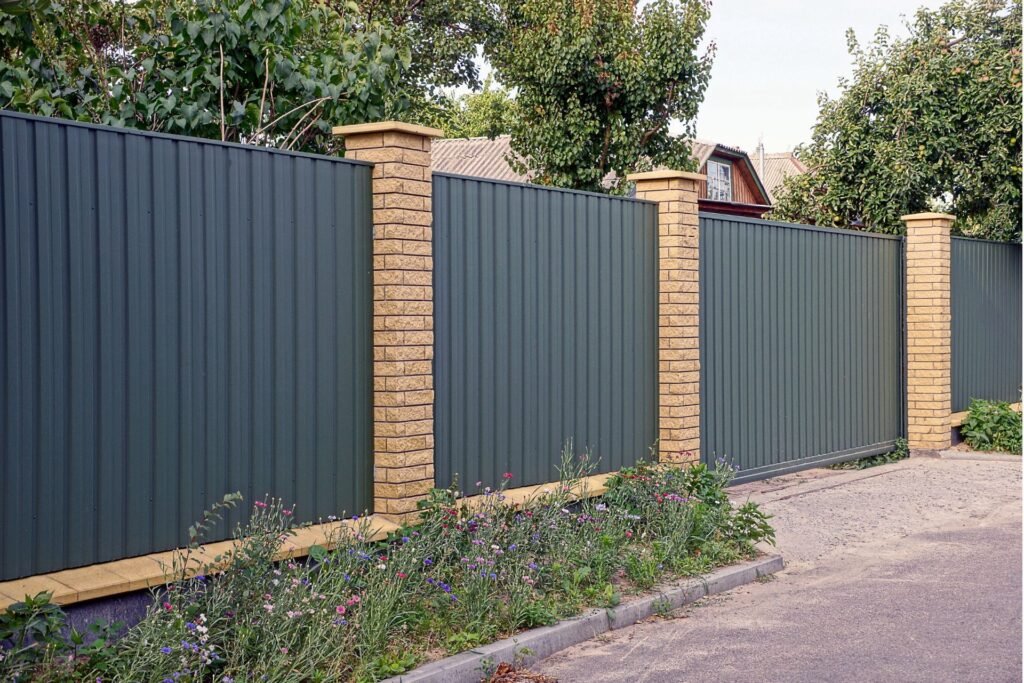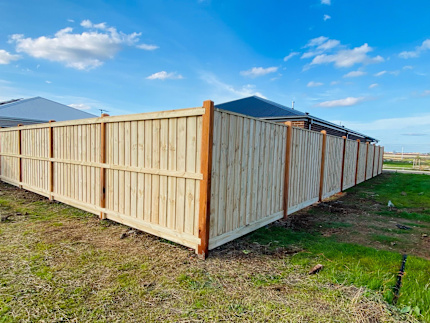A Visual Overview of What Fence Company Services Include
A Visual Overview of What Fence Company Services Include
Blog Article
A Comprehensive Guide to Fencing Install: What You Need to Understand About Secure Fencing Provider
When it comes to mounting a fencing, you have actually got a lot to ponder. You'll need to evaluate your residential or commercial property and determine if you desire to take on the installation on your own or employ a professional.
Comprehending Various Kinds of Fence Materials
When you're selecting a fencing, understanding the various kinds of fencing materials is necessary. Each material uses unique benefits and downsides, impacting your decision. Timber supplies a traditional appearance and can be personalized, however it needs normal maintenance and may rot over time. Vinyl is low-maintenance and resilient, standing up to fading and bugs, however it can be costlier upfront. Chain-link fencing is cost-efficient and useful for confining big areas, though it does not have personal privacy and visual charm. Metal secure fencing, like functioned iron or light weight aluminum, provides stamina and elegance however may require corrosion defense. Compound materials mix the very best of wood and plastic, using longevity with an all-natural appearance. Consider your spending plan, desired aesthetics, and maintenance preferences when assessing these options. Inevitably, picking the best material will assist you develop a fence that fulfills your needs and boosts your residential property's worth.
Evaluating Your Home and Secure Fencing Demands
Before you begin your fencing setup, it's necessary to examine your residential or commercial property borders and the purpose of your fence. Recognizing local guidelines and licenses will additionally help you stay clear of any kind of lawful problems down the line. By taking into consideration these aspects, you'll ensure your fence meets both your requirements and community requirements.
Residential Property Limits and Lines
Understanding your home limits is essential for a successful fencing installment, as it not only aids you establish where your fencing will go however also assures you're valuing your next-door neighbors' room. Begin by assessing your home deed or survey, which normally lays out the specific boundaries. You could likewise desire to speak with an expert surveyor if you're not sure.
Once you have actually established your boundaries, note them clearly with stakes or flags. This aesthetic help will certainly lead you throughout the installment and stop any type of disagreements with neighbors. Bear in mind, regional zoning regulations may dictate fencing placement and elevation, so inspect those laws too. Taking these steps guarantees your fencing is correctly placed and certified, making the entire procedure smoother for you.
Function of Secure Fencing
Third, fence can specify your residential or commercial property limits, making it clear where your area finishes and your neighbor's begins. A well-placed fence can aid handle noise from nearby roadways or next-door neighbors and even keep family pets and children secure. By reviewing your particular needs, you can pick the right kind of fence to accomplish these benefits efficiently.

Local Rules and Permits
How can you guarantee your fence setup adheres to local regulations? Begin by getting in touch with your neighborhood zoning office or local web site. Fence Company. They frequently have standards about fencing height, materials, and positioning. You'll also intend to discover if you require an authorization before beginning your job. Some areas need authorizations for any type of brand-new fence, while others might just need them for taller frameworks.
Additionally, consider property lines and any type of easements on your land. Marking your borders can prevent conflicts with neighbors or potential legal issues. By understanding these guidelines upfront, you can prevent costly blunders and determine your fence is constructed to last, enhancing both your property's worth and your comfort.
Local Rules and Permits for Secure Fencing
Before you start your fence task, it is very important to inspect neighborhood guidelines and get any type of necessary licenses. Each city or county has its own guidelines regarding fencing elevation, materials, and placement. These guidelines guarantee that your fencing abides with safety requirements and neighborhood visual appeals.
You may need to send a fence plan, outlining dimensions and products. Some areas may even require a survey to verify building boundaries.
Ignoring to follow these laws can bring about penalties or forced elimination of your fence, wasting both time and cash. So, make the effort to study and protect the correct authorizations for a smooth installation procedure. This action is crucial in making certain your project straightens with neighborhood laws and community requirements.
Choosing Between DIY Installation and Specialist Solutions
Are you considering whether to deal with the fencing installation on your own or hire a specialist? This choice depends upon a number of elements. Analyze your ability degree. If you come in handy and have experience with similar projects, do it yourself may conserve you cash. Nevertheless, Bonuses be sincere regarding your abilities; blunders can bring about added costs and headaches.
Installing a fencing takes time, and if you're juggling a busy schedule, employing a professional can guarantee it obtains done successfully. If your backyard has tough terrain or particular design requirements, experts bring proficiency that can make a difference.
Finally, variable in regional policies. A professional knows the authorizations and codes required, helping you stay official statement clear of possible penalties. Ultimately, weigh your abilities, time, intricacy, and laws to make the best selection for your fencing task.
Step-by-Step Overview to Fence Installation
As soon as you've made a decision to move on with your fencing installment, complying with a structured detailed approach will guarantee a smooth procedure. Beginning by marking the fencing line with stakes and string to imagine the design. Next, check local laws to verify compliance with height and residential property lines.
Dig message holes a minimum of two feet deep, spaced according to your fence kind-- normally 6 to 8 feet apart. Place the blog posts right into the holes and fill them with concrete for stability. As soon as the posts are established, connect the straight rails or panels, seeing to it they're level.
Secure the panels or pickets, validating they align properly. If you're utilizing entrances, install them last, ensuring they turn freely. Check for any loosened links and make required adjustments. Your fencing needs to currently prepare to improve your residential or commercial property and give the privacy or security you require!
Maintenance Tips for Longevity of Your Fence
To keep your fence looking excellent and long-term much longer, routine maintenance is vital. You must establish up a cleansing routine, inspect for any type of damage, and apply safety finishes as needed. By staying aggressive with these jobs, you'll ensure your fencing remains durable and appealing for several years ahead.
Routine Cleaning Set Up
Start by washing your fence with water at the very least when every season to remove dirt and particles. Do not fail to remember to inspect for any corrosion on metal fencings; a cord brush can aid eliminate it, adhered to by a layer of rust-resistant paint. Maintaining your fence clean not only improves its appearance but likewise prolongs its life, conserving you cash in the lengthy run.
Check for Damages
Consistently inspecting your fence for damage is essential if you want to maintain its stability and long life. Beginning by walking around your fencing to look for visible indications of wear, such as splits, loosened his response boards, or corrosion. Check for any type of indications of pests, like termites or woodpeckers, that might compromise your fencing's structure.
Apply Safety Coatings
After examining your fencing for damages, using safety coverings is an essential action in guaranteeing its longevity. Relying on the product, you'll wish to select the ideal kind of covering. For wooden fences, a premium sealant or wood tarnish can prevent wetness absorption and hinder insects. If your fencing is vinyl or metal, think about a UV-protective spray or paint to stop fading and corrosion.
Make certain to cleanse the surface thoroughly prior to application, as dirt and crud can weaken the layer's efficiency. Apply the finish in dry weather for far better bond, and do not fail to remember to follow the producer's instructions for the best outcomes. Frequently reapply every few years to maintain your fence looking excellent and standing solid versus the elements.
Cost Factors To Consider and Budgeting for Your Fence Job
When intending your fence task, understanding price considerations is vital to staying within spending plan. Start by figuring out the kind of material you want, as expenses can vary significantly in between timber, plastic, and metal. Don't forget to aspect in labor expenses-- employing professionals may save you time but can boost your general expenditures.
Following, gauge your residential or commercial property to calculate the linear video footage needed, as this directly influences product costs. In addition, think about any kind of permits you might require, which can include to your spending plan.

Finally, it's a good idea to establish aside a contingency fund for unforeseen expenses. By intending very carefully and taking into consideration these factors, you can create a reasonable spending plan that meets your secure fencing needs without breaking the financial institution.
Often Asked Inquiries
The length of time Does the Average Fencing Setup Take?
The standard fencing setup usually takes one to three days, depending on the fencing type and size of your yard. You'll require to take into account any type of hold-ups due to weather or allow requirements as well.
What Should I Do if My Fencing Is Damaged?
If your fence is harmed, first assess the extent of the damage. Repair small problems on your own, but also for major issues, take into consideration speaking to a professional. Do not wait too long; it'll aid prevent further issues.
Can I Install a Fence on an Incline?
Yes, you can install a fencing on an incline. You'll need to readjust your installment technique, either by tipping the panels down or making use of a racked style to assure stability and proper positioning with the terrain.
What Are the very best Practices for Fence Painting?
To paint your fencing efficiently, start with correct cleansing and sanding. Usage high-grade paint and use in even strokes. Don't neglect to pick the right climate for painting, ensuring it's dry and mild.
Exactly how Frequently Should I Check My Fence?
You ought to inspect your fencing at least twice a year, concentrating on indicators of damages, rot, or corrosion. Normal checks assist you catch problems early, guaranteeing your fence remains tough and visually enticing much longer.
Report this page